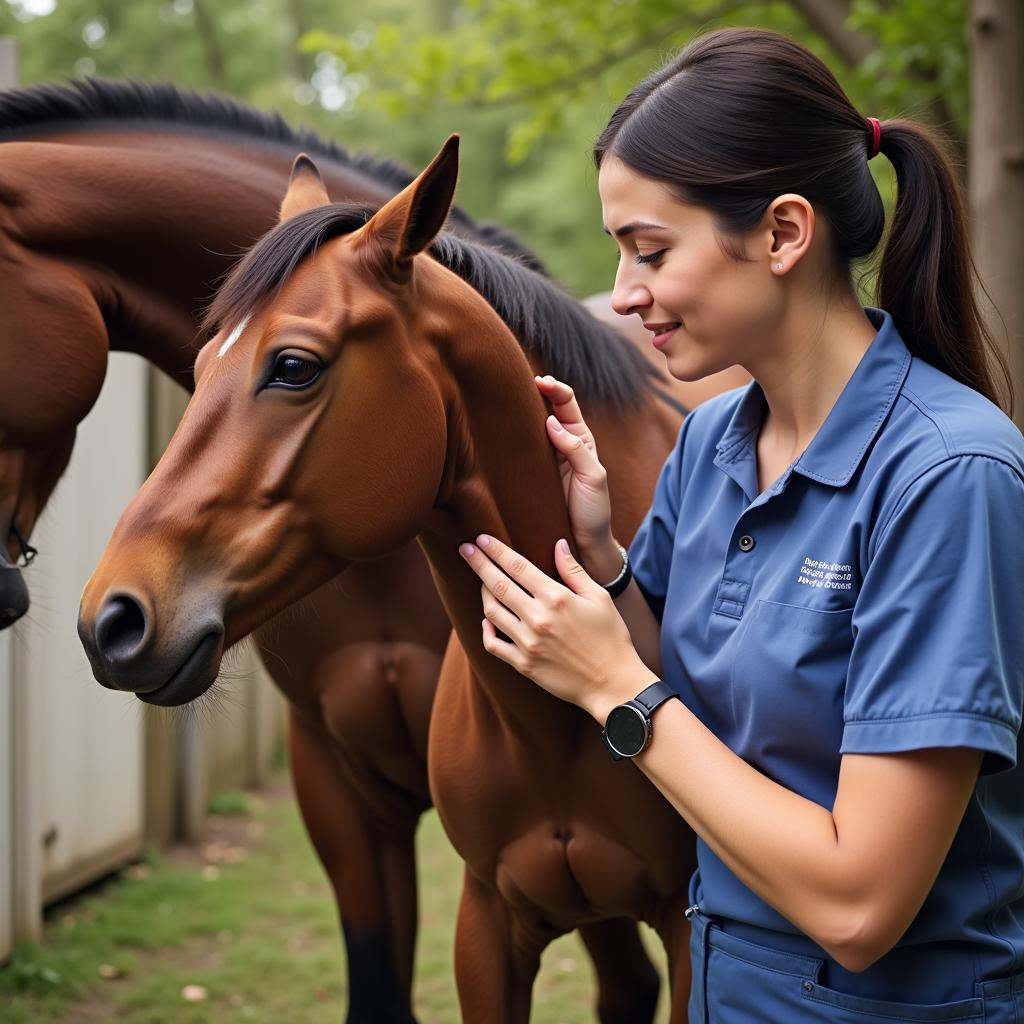Lymphosarcoma, a type of cancer affecting the lymphatic system, is a significant concern for horse owners. This article delves into the complexities of lymphosarcoma in horses, providing valuable information on its causes, symptoms, diagnosis, and treatment options.
What is Equine Lymphosarcoma?
Lymphosarcoma, also known as lymphoma, is a cancer originating in lymphocytes, a type of white blood cell crucial for the immune system. In horses, lymphosarcoma can manifest in various forms, impacting different organs and systems. It’s a challenging disease, but understanding its nuances can help owners make informed decisions about their horse’s care.
Types and Symptoms of Lymphosarcoma in Horses
Equine lymphosarcoma is categorized into multicentric, alimentary, mediastinal, cutaneous, and solitary forms. Each type presents unique symptoms. Multicentric lymphosarcoma, the most common form, involves multiple lymph nodes and often affects internal organs. Symptoms may include fever, weight loss, lethargy, and swollen lymph nodes. Alimentary lymphosarcoma affects the gastrointestinal tract, leading to colic, diarrhea, and weight loss. Mediastinal lymphosarcoma impacts the chest cavity, causing respiratory distress. Cutaneous lymphosarcoma manifests as skin nodules or ulcers. Finally, solitary lymphosarcoma involves a single tumor in a specific location.
Diagnosing Lymphosarcoma in Horses
Diagnosing lymphosarcoma requires a combination of physical examination, blood tests, ultrasound, and biopsy. A thorough physical exam can reveal swollen lymph nodes or other abnormalities. Blood tests may show changes in white blood cell counts and other indicators. Ultrasound imaging can help visualize internal organs and detect tumors. A biopsy, the definitive diagnostic test, involves collecting a tissue sample for microscopic examination to confirm the presence of cancerous cells.
Treatment Options for Lymphosarcoma in Horses
Treatment options for lymphosarcoma vary depending on the type, stage, and location of the cancer. Chemotherapy is the most common treatment, aiming to kill cancer cells and slow disease progression. While chemotherapy can be effective in some cases, it may not be curative. Supportive care, including pain management, nutritional support, and fluid therapy, plays a vital role in improving the horse’s quality of life. In some cases, surgery may be an option to remove localized tumors.
“Early diagnosis is crucial for managing lymphosarcoma,” advises Dr. Emily Carter, DVM, a leading equine oncologist. “The sooner we identify the disease, the more effectively we can tailor treatment plans to improve the horse’s prognosis.”
 Veterinarian Performing a Physical Exam on a Horse
Veterinarian Performing a Physical Exam on a Horse
Living with a Horse with Lymphosarcoma
Caring for a horse with lymphosarcoma requires dedication and attention to detail. Regular monitoring, including blood tests and physical exams, is essential to track disease progression and adjust treatment as needed. Providing a comfortable and stress-free environment, along with a balanced diet, can significantly enhance the horse’s well-being. Open communication with your veterinarian is vital for addressing any concerns and making informed decisions about your horse’s care.
Conclusion
Lymphosarcoma is a complex and challenging disease, but early detection and appropriate management can improve a horse’s quality of life. By understanding the different types, symptoms, diagnostic methods, and treatment options, horse owners can be better equipped to navigate this difficult diagnosis. Remember, regular veterinary checkups are crucial for early detection and prompt intervention.
FAQ
- What is the most common type of lymphosarcoma in horses? Multicentric lymphosarcoma.
- Is lymphosarcoma in horses contagious? No, lymphosarcoma is not contagious.
- What is the prognosis for a horse with lymphosarcoma? The prognosis varies depending on the type and stage of the cancer.
- Can lymphosarcoma in horses be cured? In some cases, remission can be achieved, but a cure is often difficult.
- What are the early signs of lymphosarcoma in horses? Swollen lymph nodes, fever, weight loss, and lethargy.
- How is lymphosarcoma in horses diagnosed? Through physical exam, blood tests, ultrasound, and biopsy.
- What are the treatment options for lymphosarcoma in horses? Chemotherapy, supportive care, and sometimes surgery.
“Regular checkups and a strong relationship with your vet can help catch diseases like lymphosarcoma early,” emphasizes Dr. Sarah Mitchell, DVM, an experienced equine veterinarian. “This proactive approach can greatly impact the outcome for your horse.”
For more information or if you need assistance, please contact us: Phone: 0772127271, Email: justushorses@gmail.com, Address: QGM2+WX2, Vị Trung, Vị Thuỷ, Hậu Giang, Việt Nam. We have a 24/7 customer support team. You can also find related articles on our website about equine health and wellness.